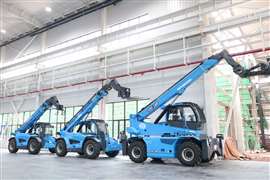A variable approach to demolition in Brazil
10 December 2015
This summer, Brazilian company Fabio Bruno Construções imploded 19 silos and one concrete building at the brewer AB InBev’s site in Rio de Janeiro.
The silos, which were 44 m (144 ft) high, included a total of that measured 10 m (33 ft) across with columns of 5.8 m (19 ft) supporting them. The diameter of the other nine smaller silos was 3.3 m (10.8 ft), and the columns measured 4.2 m (13.8 ft).
As well as the silos, a 42m (138 ft) high concrete building with access to the silos was imploded. Because of this, the silos had to be overturned away from the building.
On June 15, Fabio Bruno began demolition engineering studies in partnership with structural analysis software supplier Applied Science International (ASI) to define the safest and most effective way to implode the silos.
The partners modelled and analysed seven three-dimensional (3D) demolition scenarios and came to the conclusion that the pillars in the smaller silos could not be detonated, because the silos would squat rather than falling.
In the larger silos, it was only possible to detonate the first two rows of columns, leaving the last three rows to ensure the rotation of the silos during the implosion. Finally, Fabio Bruno and ASI determined that they make a V-cut made in the structure of the silos.
To create the V-cut, the walls of predefined silos for the V-cut were demolished. This was mainly a mechanical process, though in some places where access was difficult, it was done manually. The connections between the silos were kept only for the moment of detonation. Another 3D simulation was performed to ensure the stability of the structure with the proposed weakening.
In addition, horizontal cuts made on the back of the silos – 13 in total – made sure that there was no resistance at the time of detonation. Each cut was made with a hydraulic hammer for the concrete and a blowtorch to cut the steel.
To minimise the risk of squatting the structure, and to avoid kick back of the pillars, Fabio Bruno realised it needed to create a recycled material lining at the back of the silos embracing the last line of pillars. This liner would also serve to protect against flying debris and cushion the concrete building behind the silos.
With the simulation results confirming that overturning the silos was possible, holes were drilled in the walls and concrete columns to be detonated, and screens placed for protection against flying debris.
During preparations for the implosion, the equivalent of 5,000 m3 (176,500 ft3) of concrete and masonry was recycled. This material came from other areas being demolished and was transported to the silos for the creation of the protection liner, which was completed five days before the implosion.
On July 16, the task of distributing and charging 325 kg (716 lb) of explosives began in the 1,800 holes already made in silos and pillars.
In front of the silos, there was a pipe buried 60 cm (24 in) deep that supplied water throughout the still active facility. To protect this pipe, a lining 1 m (3.3 ft) high was built on each side of the pipe and a specialist team was on site when the implosion took place, to repair any damage if necessary.
Within 30 m (98 ft) of the silos, a power station was continuing to supply the factory. The doors and windows were sealed, and a water suppressor placed near the entrance, to stop dust from getting into the building.
Across the silos, the power line was relocated because it was under 2 m (6.6 ft) from the silos. It posed a potential risk at the time of implosion, due to the air displacement caused by the falling silos.
For the implosion, three seismographs were installed to verify the generated ground vibration. In addition, six dust sensors were also installed to begin a new study in partnership with ASI, to analyse the volume of dust generated in future implosions and how to minimise this effect.
The implosion occurred at exactly 7 am on July 19. Because the local area is densely populated, two busy avenues were closed, and several sirens played at the same time so the noise of the detonation did not scare people living within a 500 m (1,640 ft) radius.
The client chose the date and time of the detonation. Being a Sunday, it had all day to repair any damage, clean the side street alongside of the silo – which would be used again at 10 pm – and test the factory’s hydraulic and electric systems.
At locations 50 m (164 ft) from the silos, vibration of only 0.89 mm/sec made for a successful outcome.
Fabio Bruno said that in the end, the client was extremely happy. Apart from the result, there was no damage to pipes or power plant, and all possible variables relating to the implosion had been tested. When the results were confirmed, they were exactly what the engineers expected.
This article is adapted from the November –December 2015 issue of Demolition & Recycling International. To see the full article with additional project information and photos, or to register to receive regular issues of the magazine, please visit www.khl.com/subscriptions/dri






